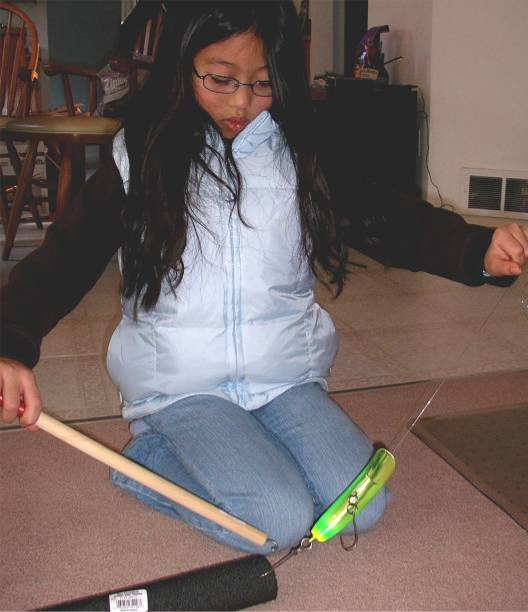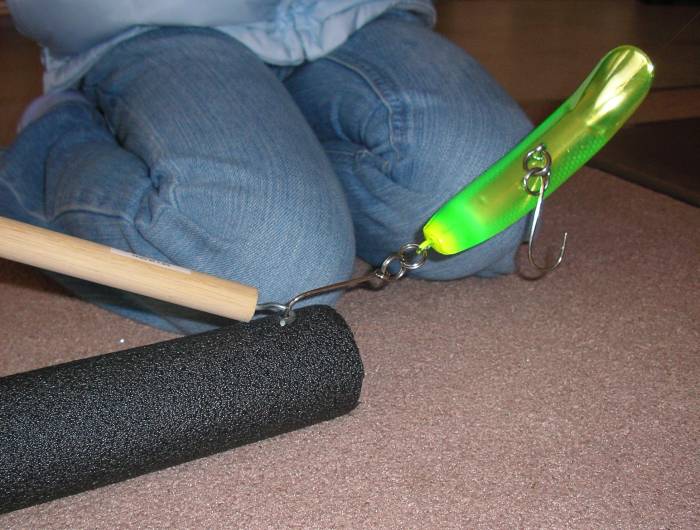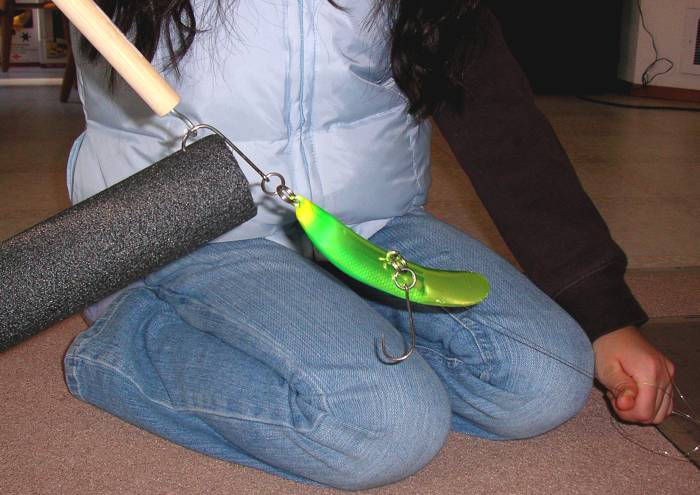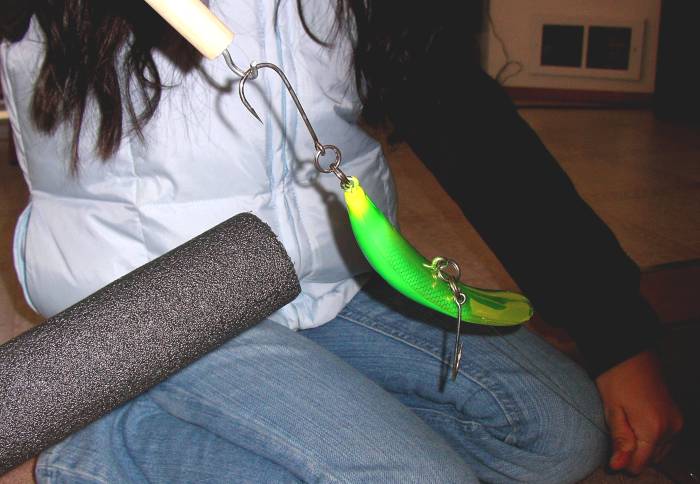|
This information
will help show you how to effectively release undersized or non targeted fish so that they survive. Everyone who goes recreational fishing should have the
knowledge how to
release fish correctly.
A fish out of
water - biological facts
The body and gills
of fish need to be supported by water. Out of water, the gills collapse
and stop working. The internal organs are easily damaged by
squeezing too hard or by the impact of the fish thrashing on hard surfaces.
Fish scales are
covered by a mucous layer which helps prevent infections. Rough handling,
especially with dry hands, or a stiff nylon net bag damages the mucous layer and reduces the chances of
the fish surviving after release.
Rules
The Washington
State Department of Fish & Wildlife as put in their fishing
regulations, as stated in the 2005 WDFW some freshwater regulations
states, "All salmon
required to be released may not be totally removed from the water, except
anglers fishing from boats 30 feet or longer as listed on either their state or
Coast Guard registration are exempt" from this rule.
In some saltwater marine areas all it may say is "Handling rule
in effect for wild CHINOOK, wild Coho, and Chum.
What this really means is "Handling Rule; In areas 5-13, it is
illegal to bring a wild SALMON or a species of salmon aboard a vessel if it is
unlawful to retain those SALMON. "Aboard a vessel" is defined
as inside the gunwale." I guess the main thing to do is spend
LOTS of time reading the regs. as it seems selective in that some areas
are covered, while others next door are not.
The preferable method would be to not remove the undersize or non-targeted fish from water, or if you
do, use a method least likely to damage the fish & ensure it's survival
once returned to the water.
Getting the
hook out
The Washington Dept. of Fish & Wildlife has come up with a simple
combination
measurement tool & de-hooker. This unit is a 22", 3/8" dowel with a screw in
hook attached to one end. The 22" was designed to be used as a
minimum measurement length for
Blackmouth.
In use, with a barbless hook, the fish is in question should be left
in the water, pulled alongside & measured with the dowel. If it is
undersize, or a non-targeted specie, take ahold of the leader about 12-18" above the fish with
one hand, the de-hooker hook is then hooked onto the leader about a foot in front of the fish,
slide it down the leader to the bend of the hook in the fish's mouth.
(In the below illustrations since the plug is in the way, she had to lock
onto the rear hook itself.) Now with the dowel in the one hand, and the leader in the other hand, quickly raise the dowel and at the same time
you lower the leader hand to near
the water. The weight of the fish will usually pull the hook
out. If it does not on the first try then in this position shake the
dowel. With a barbless hook, this will usually unhook the fish
without it leaving the water for more than a few seconds.
| Here
the de hooker is ready to pick up the lure |
Here
the dehooker is onto the hook in the "fish" |
 |
 |
| Here
raising the dehooker handle while lowering the other hand, gains
leverage |
Here a
slight jerk or just the weight of the "fish" the hook
becomes detached. |
 |
 |
If this does not
work, and the fish are hooked
in the mouth, you should extract the hook as carefully as possible.
The preferable situation is to leave the fish in the water, as it
will usually tend to be calmer and will struggle less. The next
ideal situation would be to remove the hook while the fish is still in the
net, but the fish is laying on it's back in the water. Try to push the
hook back the way it came and try not to tear the mouth. Hook removers or
long-nosed pliers can help to get a secure grip on the hook.
Cut the line
for gut-hooked fish
If a fish has
swallowed the hook, it is very likely to die if you try to remove it.
Do not
pull hard on the line. This is sure to cause internal damage. Cut the leader as
close as you can to the mouth. If you lose a hook
in the process of releasing a fish that would otherwise die, consider this as
a small price to pay for the enjoyment you gain from fishing.
Barbless hooks make
releasing mouth hooked fish easy. You can make your hook barbless by either
flattening the barb with pliers, or filing the barb off.
Having removed the
hook, return the fish to the water head first, as gently as you can from the
least possible height. Hold onto the fish's body in front of the tail, and
gently push the fish forward & then pull it back. This forces water
into the gills & gives the fish a head start on revival. When the
fish has revived it will swim away from you.
Handling
larger fish
Where possible, do
not remove large fish from the water at all. With a sturgeon that is just sub-legal,
even a 41" will still be quite a big fish at around 20#. Sturgeon are
reasonably tolerant of handling, but are strong and active, and difficult to
control in a small boat. One way of controlling them is to leave the fish
in the landing net while you remove the hook, then return it to the water.
Most fish will trash around more when removed from the water.
Handling fish
- wear gloves
Many professional
fishers and marine biologists only handle live fish while wearing wet gloves.
Wet cotton gloves are the best, but cheap rubber gloves are almost as good.
For small undersize
fish, you will probably only need to put on one glove. You should also ensure
that your other hand and the glove is wet.
Never hold a fish
you intend to release by
putting your fingers inside the gill covers or eye sockets.
If you need to
handle a live rockfish, hold the back of its head in the gill cover area.
If
you grip from below the jaw, you should avoid being spiked by the fish.
When holding a
fish, hold it around the gill covers with one hand and support the body with
the other
Size limits
You should know the
minimum legal size limits as there are large penalties for breaking the law.
The size limits are set to allow fish to return & or breed therefore
creating more & keeping a healthy population.
Most sport caught fish
are measured from the shortest distance from the tip of the nose to end the tail. Size limits can vary
from area to area. For Washington State the size below is
common.
Minimum size for Coho salmon
is 16"
Minimum size for Chinook salmon is 24" (some years the
coastal size can be a minimum of 26")
Minimum size for Blackmouth Chinook salmon is 22"
Minimum size for Sturgeon is 42" with a maximum size of 60", with a
mid year minimum of 45"
For Coho &
Chinook any fish that is under this size is considered a
"Jack". This terminology is referring to a fish that has
gotten the urge to return a year early. Most of these will be males,
however you may on occasion catch a "Jill", but this ratio is very
small.
There are some
rivers that in the fall, will be open for retaining of mature salmon plus some
jacks. The jacks are a bonus, as they are not a viable breeding stock,
and the WDFW would rather see them taken home.
Quantity Limits
Also for the year 2004 WDFW has imposed a limit of Zero retention of
Yelloweye,
(commonly called red snapper), & Canary Rockfish in your bag limit. This can pose a
problem as these fish can be located in the same general deep water area as
halibut. When you bring one of these up from this deep water, it gets
the "bends" & it's stomach will generally turn inside out & pop out the fish's mouth.
If you throw them back, the protruding internal parts do not return
into the fish. Scavengers will then kill these fish.
There have been experiments as to what to do to alleviate the above problem.
One is venting by using a large hypodermic needle & vent at the
proper location in the body. Another method would be to use a weighted
hook system & send the fish back down. For a link to a page of
concern & possible methods of helping, CLICK
HERE.
Avoid catching undersize fish
The best way to protect small fish is to not catch them at all. Use a large hook and a bigger bait as these are less likely to be swallowed by small fish.
Move away from the area where most of the fish are small.
Remember to do
these things
DO remove
fish from the water only if you have to.
DO wear wet
cotton or rubber gloves or at least wet your hands.
DO lie fish
on a soft wet surface & roll them over on their back if you need to handle them out of the water.
DO change to
a larger hook size if you are catching a lot of undersize fish.
DO minimize the time fish are out of the water.
DO remove the
hook carefully from lip hooked fish.
DO cut the
line for gut hooked fish.
DO return
fish gently to the water.
Do not
Don't hold
fish by inserting your fingers inside the gill covers.
Don't poke or
touch the eyes, and never hold fish by the eye sockets.
Don't squeeze
the gill covers or gut area hard.
Don't lift
fish by the tail as this can dislocate the spine & harm internal organs.
Don't drop or
place fish on a hot dry deck or on rocks.
This information provides guidelines on how to release fish that are smaller than
or larger than the legal size or are non-targeted species requiring their
release. Bag limits and size limits may vary from area to area, so check the
regs.
Originated
7-08-2001, Last Updated 01-24-2006
LeeRoy Wisner
| 


